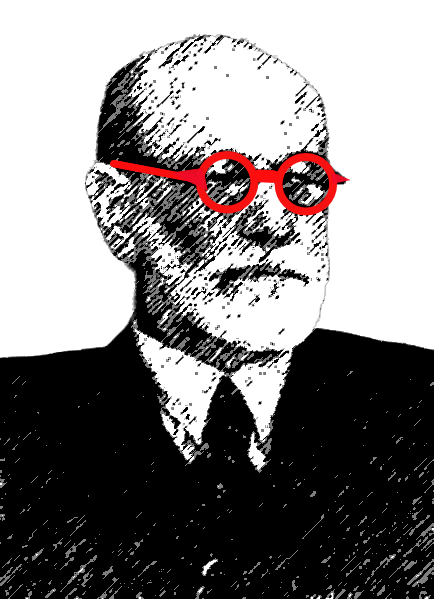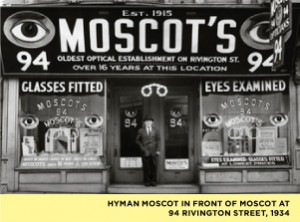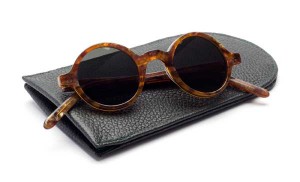
Sigmund Freud’s glasses are as central to his image as his cigars are — perhaps more so. After middle age, Freud is never photographed sans specs, but his smokes are occasionally absent.
Yet while Freud’s cigars are much analyzed, his eye wear remains a mystery.
Maybe Moscot?
 My interest in the topic was piqued earlier this week when my friend Penelope Starr wrote me that a friend of her son’s works for a company called Moscot that “made Freud’s glasses.”
My interest in the topic was piqued earlier this week when my friend Penelope Starr wrote me that a friend of her son’s works for a company called Moscot that “made Freud’s glasses.”
She knew I’d bite.
I checked the site. Sure enough, the company sells frames that look like the ones Freud wore. But according to the history section:
The MOSCOT optical roots were first planted in America by Great Grandfather and family patriarch, Hyman Moscot, who arrived from Eastern Europe via Ellis Island in 1899. Hyman began selling ready-made eyeglasses from a pushcart on Orchard Street on Manhattan’s famed Lower East Side, and the rest, as they say, is history!
The company left Europe before the start of the 20th century, thus eliminating Moscot from the running as Optician to Freud.
I also found plenty of sites advertising knockoff Freud specs — for example, the Neue Gallery’s stylish Sigmund Freud shades ($385) with a replica leather case ($128), pictured below: But when it came to finding information about Freud’s actual glasses — nada.
But when it came to finding information about Freud’s actual glasses — nada.
Optical Delusion?
In addition to wondering where Freud bought his glasses, I wanted to know: What did he need them for? Nearsightedness? Astigmatism?
To that end, I wrote to the Freud Museum in Vienna, and received a prompt answer:
Unfortunately we ourselves have little information on Freud’s glasses or his eyesight. The only thing I can tell you is that glasses like his were quite common in style during the first third of the 20th century. He owned more than one pair, and I know of two still existing ones: the one here in Vienna, which is made of celluloid, and the one in London, which has a metal frame. Both materials were common for frames.
By coincidence, I had gone to my optometrist last week to get my eyes checked. Reading this response, I couldn’t help but recall a machine in the eye doctor’s office. Every year, a technician puts my glasses into it — and voila! The details of my prescription emerge.
Surely they have such machines in Vienna.
Maybe it’s an insurance issue. No one wants to be responsible for carrying Freud’s glasses to an optician to get them checked. But I’d bet Lloyd’s of London could handle it.
Speaking of London, I wrote to the other Freud Museum for a second opinion.
Stay tuned. And feel free to spec-ulate here in the meantime.

Intriguing–that no one seems to have looked into this before! And somehow very amusing–the thought of someone carrying Freud’s glasses (carefully–in those days the lenses were breakable!) to the optician.
Follow-up…Actually, the thought of Freud’s glasses on their own reminds me of an odd experience I had–in Vienna, as it happens. I visited Franz Schubert’s birthplace, a very small house not all that far from where Freud lived when he first moved to Vienna (I think). In one of the rooms, Schubert’s wire-rimmed glasses were displayed all by themselves in a tall free-standing glass case, so that you could walk all the way around them and, most strangely, bend down and look through them out the window at the houses opposite. Now that was uncanny–to look through his glasses at a sight that he must have seen.
That *is* interesting — especially for the contrast with Freud’s glasses. If you looked through Schubert’s lenses, you would know, roughly, what his prescription was, whereas no one thought to provide a similar perspective for Freud.
I’ve been interested in the idea of how people see the world — literally — ever since I heard that Velazquez’s painting style was dictated by his astigmatism. I suppose Freud’s vision isn’t that relevant to his ideas, but still… I can’t imagine no one has wondered before.
I didn’t know that about Velazquez. It reminded of something I heard Oliver Sacks say about Rembrandt having a problem with depth perception–which made him pay more attention to light and shadow or order to help him judge distances. I Googled to make sure I had the right painter and found this article… http://www.boston.com/news/nation/articles/2004/09/16/an_eye_on_rembrandt/?page=full
This is a very interesting thread — artists whose uncorrected eyesight had an effect on their work. I didn’t know that about Rembrandt. Although the article talks about the danger of talking about art from a scientistic perspective, I still wonder at what point corrective lenses became popular. Otherwise you can start thinking about all those artists who paint elongated figures — Ingres, Modigliani — and of course the cubists!
Freud’s glasses in Vienna are for long-sightedness. Also, according to pictures, he seemingly wore glasses only in old age.
Best Regards,
Freud Museum Vienna
Thanks very much for coming by. I got the exact prescription recently from London: https://freudsbutcher.com/psychology/7-little-known-facts-about-sigmund-freud-including-the-prescription-of-his-glasses/
Yes, I wonder at what age Freud began wearing glasses. He is so much associated with them–along with his cigars–but as you say he didn’t always wear them.